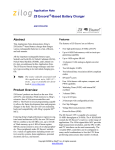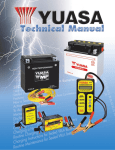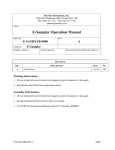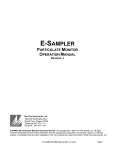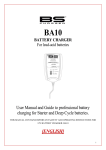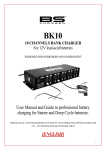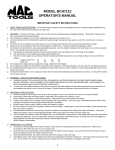Download Yuasa YUA1200901 Operating instructions
Transcript
12V 900mA Charger IMPORTANT SAFETY INSTRUCTIONS: SAVE THESE INSTRUCTIONS THIS MANUAL CONTAINS IMPORTANT SAFETY AND OPERATING INSTRUCTIONS FOR 12V BATTERY CHARGER, VM12990‑02. KEEP IT WITH OR NEAR CHARGER AT ALL TIMES. 1. 1.1 1.2 1.3 1.4 1.5 1.6 1.7 1.8 2. 2.1 2.2 2.3 2.4 2.5 WARNING ‑ RISK OF EXPLOSIVE GASES. WORKING IN VICINITY OF A LEAD‑ACID BATTERY IS DANGEROUS. EXPLOSIVE GASES DEVELOP DURING NORMAL BATTERY OPERATION. IT IS IMPORTANT THAT EACH TIME BEFORE USING YOUR CHARGER, YOU READ THIS MANUAL AND FOLLOW THE INSTRUCTIONS EXACTLY. To reduce risk of battery explosion, follow these instructions and those published by battery manufacturer and manufacturer of any equipment you intend to use in vicinity of battery. Review cautionary marking on these products and on engine. Do not expose charger to rain, snow, or liquids. Use of an attachment not recommended or sold by the battery charger manufacturer may result in a risk of fire, electric shock, or injury to persons. To reduce risk of electric shock, unplug charger from AC outlet before attempting any maintenance or cleaning. Turning off controls will not reduce this risk. An extension cord should not be used unless absolutely necessary. Use of improper extension cord could result in a risk of fire and electric shock. If extension cord must be used, make sure that pins on plug of extension cord are the same number, size and shape as those of plug on charger and that the extension cord is properly wired and in good electrical condition and that the wire size is large enough for AC ampere rating of charger as specified in the following table: RECOMMENDED MINIMUM AWG SIZE FOR EXTENSION CORDS FOR BATTERY CHARGERS Length of cord (feet): 25 50 100 150 AWG size of cord: 18 18 18 18 If charger is equipped with an input power cord, do not operate charger with damaged cord or plug ‑ replace the cord or plug immediately. Do not operate charger if it has received a sharp blow, been dropped, or otherwise damaged in any way; take it to a qualified serviceman. Do not disassemble charger; take it to a qualified service center when service or repair is required. Incorrect reassembly may result in a risk of electric shock or fire. PERSONAL PRECAUTIONS Someone should be within range of your voice or close enough to come to your aid when you work near a lead‑ acid battery. Have plenty of fresh water and soap nearby in case battery acid contacts skin, clothing or eyes. Wear complete eye and clothing protection. Avoid touching eyes while working near battery. If battery acid contacts skin or clothing, wash immediately with soap and water. If acid enters eye, immediately flush eye with running cold water for at least 10 minutes and get medical attention immediately. NEVER smoke or allow a spark or flame in vicinity of battery or engine. Be extra cautious to reduce risk of dropping a metal tool onto battery. It might spark or short‑circuit battery or other electrical part that may cause explosion. When working with a lead‑acid battery, remove personal metal items such as rings, bracelets, necklaces, watches, 702-000158 2.6 2.7 3. 3.1 3.2 3.3 3.4 4. 4.1 4.2 4.3 4.4 4.5 5. 5.1 5.2 5.3 6. 6.1 6.2 6.3 etc. A lead‑acid battery can produce a short‑circuit current high enough to weld a ring or the like to metal, causing a severe burn. Use charger for charging a Lead‑Acid Battery only. It is not intended to supply power to a low voltage electrical system other than in a starter‑motor application. Do not use battery charger for charging dry‑cell batteries that are commonly used with home appliances. These batteries may burst and cause injury to persons and damage to property. NEVER charge a frozen battery. PREPARING TO CHARGE If necessary to remove battery from vehicle to charge, always remove grounded terminal from battery first. Make sure all accessories in the vehicle are off, so as not to cause an arc. Be sure area around battery is well ventilated while battery is being charged. Gas can be forcefully blown away by using a piece of cardboard or other non‑metallic material as a fan. Clean battery terminals. Be careful to keep corrosion from coming into contact with eyes. Add distilled water in each cell until battery acid reaches level specified by battery manufacturer. This helps purge excessive gas from cells. Do not overfill. For a battery without caps, carefully follow manufacturer’s recharging instructions. Study all battery manufacturer’s specific precautions such as removing or not removing cell caps while charging and recommended rates of charge. Determine voltage of battery by contacting battery manufacturer and make sure it matches output rating of battery charger. CHARGER LOCATION Locate charger as far away from battery as DC cables permit. Never place charger directly above battery being charged; gases from battery will corrode and damage charger. Never allow battery acid to drip on charger when reading gravity or filling battery. Do not operate charger in a closed‑in area or restrict ventilation in any way. Do not set a battery on top of charger. DC CONNECTION PRECAUTIONS Connect and disconnect DC output terminals only after removing charger from AC outlet. Never allow DC output terminals to touch each other. If problems arise connecting the output leads, solicit the aid of your Dealer from whom you purchased this product or the charger manufacturer for finding a suitable connection device for your application. FOLLOW THESE STEPS WHEN BATTERY IS INSTALLED IN VEHICLE. A SPARK NEAR BATTERY MAY CAUSE BATTERY EXPLOSION. TO REDUCE RISK OF A SPARK NEAR BATTERY: Position AC and DC cords to reduce risk of damage by hood, door or moving engine part. Stay clear of fan blades, belts, pulleys, and any other parts that can cause injury to persons. Check polarity of battery posts POSITIVE (POS.,P,+) P.1 6.4 6.5 6.6 6.7 6.8 7. 7.1 7.2 7.3 7.4 7.5 7.6 7.7 8. post usually has larger diameter than NEGATIVE (NEG,N,-). Determine which post of battery is grounded (connected) to chassis. If negative post is grounded (as in most vehicles), see paragraph 6.5. If positive post is grounded, see paragraph 6.6. For negative-grounded vehicle, first connect POSITIVE (RED) clip from charger to POSITIVE (POS.,P,+) ungrounded post of battery. Then connect NEGATIVE (BLACK) terminal to vehicle chassis or engine block away from battery. For positive-grounded vehicle, connect NEGATIVE (BLACK) clip from charger to NEGATIVE (NEG,N,-) ungrounded post of battery. Connect POSITIVE (RED) clip to vehicle chassis or engine block away from battery keeping the battery terminal well-removed therefrom. Do not connect any charger clips to carburetor, fuel lines, or sheet-metal body parts. Connect to a heavy gauge metal part of the frame or engine block. When disconnecting charger, turn switches (if supplied) to off, disconnect charger from AC power, remove clip from vehicle chassis, and then remove clip from battery terminal. See operating instructions for length of charge information. FOLLOW THESE STEPS WHEN BATTERY IS OUTSIDE VEHICLE. A SPARK NEAR THE BATTERY MAY CAUSE BATTERY EXPLOSION. TO REDUCE RISK OF A SPARK NEAR BATTERY: Check polarity of battery posts. POSITIVE (POS.,P,+) battery post usually has a larger diameter than NEGATIVE (NEG.,N,-) post. Some batteries are equipped with ‘Wing- Nut’ terminals allowing for easy placement of the terminals to these posts. Attach at least a 24-inch long 18-gauge (AWG) insulated battery cable to NEGATIVE (NEG,N,-) battery post. Connect POSITIVE (RED) charger terminal to POSITIVE (POS.,P,+) post of battery. Position yourself and free end of cable as far away from battery as possible - then connect NEGATIVE (BLACK) terminal to free end of cable. Do not face battery when making final connection. When disconnecting charger, always do so in reverse sequence of connecting procedure and break first connection while as far away from battery as practical. A marine (boat) battery must be removed and charged on shore. To charge it on board requires equipment specially designed for marine use. OPERATING INSTRUCTIONS Once the connection instructions have been followed, the Red Light Emitting Diode (L.E.D.) lights when AC power is present. The Yellow L.E.D. lights to indicate ‘Charging Mode’ and that a proper connection to the battery has been made. The battery charges to approximately 14.4Vdc and then transitions into the ‘Float Mode’ where the White L.E.D. turns GREEN and the regulating voltage reduces to a lower level. The Float Mode allows the charger to effectively be left connected to your batteries, over the course of a season, without overcharging your batteries, and maintains the full charge on your batteries. A regular, periodic check on your charging system, if left unattended and powered, is still recommended (just as you would with any electrical appliance). The ‘Float Mode’ also contains a special charging waveform, that pulses power into your 702-000158 9. 9.1 9.2 10. 11. batteries, and helps to peak the power into your battery. Also, while in this mode, if the charger senses a load that has activated, the charger recycles to the ‘Charging Mode’ to start charging again, up to the 14.4Vdc level. PROTECTION DEVICES AND MEASURES OVERLOAD PROTECTION The charger employs the use of a ‘Solid State Circuit Interrupter’ that opens under severe overload. This condition may occur if attempting to charge any severely discharged or heavily sulfated battery. Once the Interrupter opens, the charger will stop charging for a short period and then resume charging automatically and the yellow. L.E.D. will be OFF, until resume charging. Overloading could be due to an external load, remove the load condition prior to attempting to recharge the battery. REVERSE BATTERY / OVERLOAD CONDITION The charger has reverse battery and short circuit protection. If a reverse battery condition exists (White L.E.D. will turn RED, only, while output leads are connected backwards), simply unplug charger from AC power and properly remake the connections as described in this manual. MAINTENANCE Store in clean, dry place. Occasionally clean the case and cords with a dry cloth. WARRANTY YUASA INC., READING PENNSYLVANIA offers this limited warranty to the original purchaser. This warranty is NOT TRANSFERABLE. THREE YEARS LIMITED WARRANTY Yuasa Inc. (Yuasa) warrants exclusively to the original purchaser that this charger will be replaced or repaired, at Yuasa’s option, if it fails during the first two years after date of purchase due to defect in material or workmanship. It is the responsibility of the purchaser to contact Yuasa Customer Service for warranty consideration. YUASA BATTERY INC. 1-866-431-4784 www.yuasabatteries.com A $5.95 handling fee must accompany the battery charger after 120 days from date of purchase. A copy of the original bill of sale is required for the limited warranty to be honored. If a copy of the original bill of sale is lost, a $12.95 handling fee must accompany the battery charger for the limited warranty to be honored. This warranty does not cover failures arising out of improper use, maintenance or operation of the product. Repair or replacement as provided under this warranty is the exclusive remedy of the consumer. Yuasa shall not be liable for any incidental or consequential damages for breach of any expressed or implied warranty on this product. Except to the extent provided by applicable law, any implied warranty of merchantability or fitness for a particular purpose on this product is limited to the duration of this warranty. Some states do not allow the exclusion or limitation of incidental or consequential damages, or allow limitations on-how long an implied warranty lasts, so the above limitations or exclusion may not apply to you. This limited warranty gives you specific legal rights, and you may also have other rights which vary from state to state. P.2



